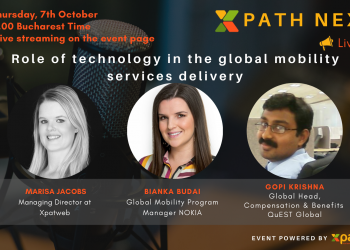[elementor-template id=”3753″]
This is dummy title and will be replaced with real title of your post
Image with size : 1140×570
Image: xpath global
This episode focuses on the Role of Technology in the Global Mobility processes delivery.
The demand for the Global Mobility function to assess the implications of digital transformation will undoubtedly increase, with pressure coming from both internal and external sources: the company and the employees themselves, as well as the outside world.
So, how do companies take advantage of the technology available, and what role does technology play in the delivery of global mobility services?
This article comes from the #XpathNEXUS Live Talks series that had as valuable guests:
Marisa Jacobs, XpatWeb
Bianka Budai, Nokia
Gopi Krishna, QuEST Global.
Q1: Would you say changes are visible in the rise of uh technology usage inside the global mobility departments comparing the current situation with what was let’s say three or five years ago?
Gopi Krishna: You know global mobility can’t be left behind. Technology is all-pervasive and it’s actually impacting every single thing that we do. Global mobility is not going to be any different from that perspective and over the last few months, the technology revolution has really just accelerated. The pandemic itself hosts a complete rethink on the way technology needs to work in different areas, so absolutely I do believe that the impact of technology on global mobility is going to be significantly seen and is already being seen. To take a few examples, the way I would think about it is where earlier technology might have been more about: how do we do case management better or SLAs better. I think technology will shift significantly into the areas of the overall experience, the overall enabling work from being done anyplace, anywhere, providing a great experience to anyone who’s undergoing global mobility taking care of aspects related to compliance. There are several different areas where I think technology is going to make a big impact on global mobility.
Q2: Is there any direct relationship between technology and compliance?
Marisa Jacobs: I would say the relationship between compliance and technology is more of an indirect relationship and we are definitely seeing technology used. For example, if I look at the Visa application process, collecting the documents and getting it submitted through to the government and using technology to facilitate that submission process to track the process, ultimately it still ends up with a human being going through the application and making an objective decision based on the documents that are being submitted.
Even in cases when technology has tightened up slightly, whether it’s a pre-approval or pre-assessment done, or in the tax, since in South Africa, it automatically gets submitted and approved and followed. There’s still that manual audit process. So my short answer is there’s very much an indirect thing and not a direct thing. It would be interesting to see how AI is going to take over, but I don’t see that happening very soon.
Gopi Krishna: It’s not like technology will completely replace the human part of it or that expertise part of it, but the way I think about it is that the area of compliance is a very complex area, specifically in global mobility that deals with laws of so many different countries. Within those every single type of assignment, for example, would have a different compliance mandate. Given those so many complexities and so many interdependencies that may exist in these areas, I think technology could be a great enabler in that decision-making. Artificial intelligence could actually expedite or make the decision-making process much better and enable better, more informed, effective, and compliant decision-making for the humans that are involved in this process.
Q3: What would be your viewpoint on the use and the role of tech in general in the GM processes? Is it helpful? Does it improve your life as a GM professional? Do we need it?
Bianka Budai: Absolutely. I’m a big fan of technology and I remember the times working without technology, so I know the struggles. It’s not magic of course, although then you spent like two hours before, trying to calculate the cost estimation for a specific country combination and needing to reach out to like 10 different sources to get the taxes, and then if you compare it to the situation now you push the button and you see the system working and you get the cost estimation, it seems magic indeed.
I would say that we are not in a comfortable situation with a tool, as we were hoping for. So it’s not like you push the button and you finish for the day, it’s not like that our challenges disappeared. I would say our challenges transformed. It’s not anymore about the burden of the administration, about the resources, the time needed. I remember two days in my calendar every month were blocked just for the reporting.
Now you have to have a good setup and then your two days are freed up, so the challenge is not on that side anymore: how do you get the time, how do you get the resources, but you have to maintain the system.
First of all, you have to implement it in a way that it’s actually useful and it’s not just causing you another burden. It’s not going to be just something else you need to do on a daily basis. It’s built in a way that it’s helping your work and it takes away from what you need to do offline in your memory and then in this millions of other manual solutions. It is an enabler, something that helps you to have time to ask your assignee how are they, how is the family, did they arrive on time etc. I would say it’s changed the mobility role.
Q4: What would be the main advantages of those tools and what challenges do they really solve in your daily activities?
Bianka Budai: I’ll start with the advantages of them. I would say a central database that it’s making sure that nothing is forgotten and nothing is missed and also the analytics part is something I really like and am really enthusiastic about.
So it’s not anymore only about reports on assignment data, geographic nice presentations on where our assignees are, but actually, this tool does know so much more on the data analytics that you can be actually partnering with business and not only react but proactively advise and talk about business plans based on data which hasn’t happened before, at least in my experience.
What was created is what I realized actually during the implementation that at the moment when you start the implementation with your service provider company, you have to be really certain about what you want and without using systems before, you don’t necessarily know but you’re going to need that. You have to have a complete final policy because it’s more difficult to make the changes afterward.
That was our realization when we started the implementation – our service provider came with 100 questions and we had to sit down and think about it. That was one challenge, that we didn’t have a program and process flows and everything in such a ready-to-use way that we just share everything with the provider, they put it in the system and we are happy. It was actually a huge work to create that because you have to tell the system exactly what you want it to do.
Another challenge was maybe to introduce this change in the team, to make sure that people actually start to use the system and they see it as beneficial. I think it’s a human thing, we are not always happy about changes. We like our old things, we like to come forward and when you do something for many, many years, it’s difficult to say “okay I’m trusting this machine now and I’m letting it do it for me”.
Q5: Did you feel any change in your colleague’s behavior towards using the tech once it was implemented? Did they see the results and the benefits afterward or it’s still another task they have to do on a daily program?
Bianka Budai: We are getting there. I think it can take years, especially that this is not a one-time activity that the system is done. You use it but it’s changing all the time. We find new features, we think that some things should work another way, so it’s a constant improvement on the system as well. I don’t feel that this is our bible yet. It’s still a little bit of trust needed between humans and machines.
Gopi Krishna: I absolutely solve several challenges that Bianka mentioned. I’ll add things like it creates transparency in the system, it makes it more compliant, it provides a better experience to anyone who is using that particular product or tool rather than when it is in a disparate, manually driven system. It takes away that individual dependency. In terms of challenges that it introduces I think the best automation solution implemented on a bad process would still result in a bad result. So it’s not really the fault of the technology or the product really. I think it starts with whether we really got the process right. The major challenge with any automation would be that first, we have to get the process right, we have to ensure that people understand the intent of that process and do it the right way.
Q7: Thinking about your clients and expatriates as final beneficiaries of services, would you say that tech is playing any role in the expatriates’ lives and relocation experience? Does it make it better or improve it in any way?
Marisa Jacobs: I think on a very basic level when an expatriate is asked to go on assignment, technology has a massive impact just in being able to research the country that you’re going to on social media. There are now groups that will be able to answer questions for them, so in that sense, I think technology helps a great deal with the unknown and people don’t have to pay school fees in terms of making the same mistakes over and over. They can just ask someone else the same question. In that way, technology really helps with the experience of relocating to another country.
On a more specific level, in terms of the actual mobility process and to apply for the visa and having that luxe visit and technology facilitating that process – I do think that it definitely helps to have information at your fingertips. But whenever there is an expatriate assignment involved there’s also a lot of handholding and they do still appreciate that one-on-one communication, the human element of it. Technology helps, but only if it is coupled with human experience, where they can still feel like they are being heard, so it’s an interesting balance.
Q8: Talking about Employee Experience, the current pandemic basically redesigned the entire EE concept and its importance – did you make use of any tech tools to locate and track your remote employees during this period? And also thinking about the new rising WFA/WFH work scenario? Or any other tools that support your activity throughout this period and had a great impact on your mobility processes?
Gopi Krishna: The pandemic was definitely a rule changer in several different areas and a big disrupter overnight. Different countries started going into lockdown and suddenly a lot of our expats were facing huge amounts of difficulties. So it was not a time where we could really think about bringing in any new technology, so we really had to make the best with what we had. Human touch can never be replaced, we actually had to probably bring in more human touch at that time.
They were enabled by technology. What we had to do is put in more people who were actually contacting the individuals for the expats in different places and providing a one-on-one experience to them: providing them the latest information, the latest support systems that we are putting in place as a global organization to ensure that they remain safe. We were providing a continuous level of information, there were several communication channels that we opened up to provide what’s happening in this particular country, what are the changing rules, etc. I really think at that time it was more the human touch but enabled by technology.
Q9: Many voices claim that mobility practitioners seem to be underutilizing available technology? Would you say this is correct from your point of view as a regional immigration expert provider? Are providers underusing tech? What tools do you have in place or think to have in place to ensure immigration compliance for your clients?
Marisa Jacobs: I think it’s a bit of a mix. I wouldn’t want to find everyone with the same brush. I do think we have technology tools and within the business and our clients insist on having those tools available to be able to check the assignments. I think the better your technology tool is, the more mobility practitioners will end up using it.
I think it depends on what they use it for, and also when you have 10 or 20 assignments, you sort of know off the top of your head exactly where everyone’s at and what you need to do. But as soon as that number gets bigger then it becomes essential to be able to harness technology. In my experience and mobility professionals are extremely proud of the technology and embrace using it.
Q10: What about your supply chain? Do you feel service providers are invested in advanced tools or are they still behind? What tools would be a must-have for a global mobility service provider so that they could meet your needs?
Gopi Krishna: You were talking earlier about fragmentation. The supply chain does use technology because I think that’s like a hygiene factor. I mean you just can’t do anything without it. So you would absolutely need to have a technology solution that covers at least the basic parts of things: whether it’s case management or SLA tracking, or document management.
However, I think when we look at it from a holistic perspective on the overall global mobility front I still feel there is less tech adoption and maybe if I could take it one step forward and say there is a need for innovation in the different cases that could exist. We are still talking about the case management SLAs and all of those aspects but is it possible for certain decision models to be expedited or facilitated by the use of technology? Is it possible for certain aspects of compliance to be red-flagged by technology itself? Is it possible to improve that experience that the individual has?
You were once mentioning to me in an earlier conversation about the use of augmented reality or virtual reality to give an experience to an assignee about where he or she may be staying in the future – the neighborhood and how the houses look like. I think there are so many use cases that are possible, there are immense possibilities from that perspective. If there are good technology solutions that could pick up that use case and really provide a solution to it, there will be several organizations that would want to implement it as part of their global mobility program.
The only additional thing I would add is data privacy rules. Whether it’s GDPR or several others that other countries have adopted, that is also going to put a lot of emphasis on organizations to invest in the right technology solutions with their service provider. For example, you don’t want to send data. Or most of this immigration-oriented data is quite sensitive, so when you send that over unprotected systems – like emails – you’re creating risks for that individual and for the organization. So those kinds of laws will also force organizations and their supply chain partners to invest in better technology solutions.
Q11: Would you say the mobility tools, you as a professional are using, could be connected to the state authority ones at some point in time? How far still are we from this scenario?
Marisa Jacobs: I think from a government perspective the wheels move slowly. I think we still have a while away that there is harnessing of technology in certain ways, but much slower being in the corporate bowl. In South Africa, we are finally looking at having e-visas for short-term visitors as many countries have adopted long ago and we are now starting to incorporate that.
We’re starting to see technology development where you can use facial recognition and where facial recognition is now a much better way to actually authenticate someone’s identity than a face-to-face visit. We’ll start seeing governments adopting such things. As that technology develops, the government will more and more start embracing technology and how it’s helping in terms of immigration processes. I think the pandemic in many ways has advanced and accelerated the use of technology and we’ll see that more and more in the next year or two.
If you missed the entire session, you may listen to it here.
Related Posts
edit post

#XpathNEXUS
Role of Technology in Global Mobility delivery
edit post

Uncategorized
Elena Antoneac, one of the Strong Women in IT 2021
edit post

#XpathNEXUS
Cost Containment: Revising global mobility policies
edit post

Immigration
Safety and Fairness for Afghans under the Special Immigrant Visa Program
edit post

Uncategorized
How to Ace an Elevator Pitch and Get High Impact in 7 seconds
edit post

Uncategorized